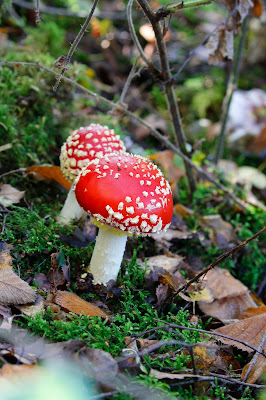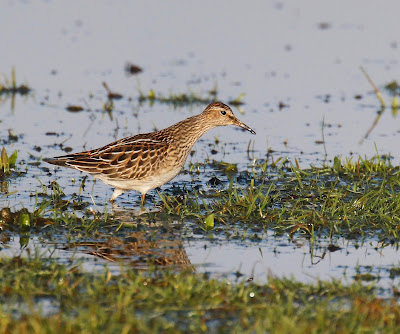A chance conversation with Peter, a birding colleague with an interest in all things natural, persuaded me to visit North Leigh Common in my home county of Oxfordshire. He had fired my curiosity by showing me pictures of a spectacular toadstool going by the name of Fly Agaric, that he had found at North Leigh a few days before.
They are highly poisonous and their red and white colouring alerts anyone to this fact. It is a natural way of saying 'keep away I am dangerous'. However there are few records of human deaths as a result of eating one. Humans have, however, made use of their hallucinogenic properties in many areas of the world where it grows and, in Siberia and with the Sami in Lapland it carries a religious significance in their respective cultures.
North Leigh Woods is a reserve owned and managed by West Oxfordshire District Council and is but a fifteen minute car drive from my home, accessed through pleasing byways and narrow lanes in the heart of rural Oxfordshire. I arrived at the small car park at just after noon and wandered down a track and into the woods.


It was a beautiful autumnal day of weak sunshine and still air. A day to enjoy but with the inevitable melancholy that accompanies the realisation that this was almost a final farewell to autumn, the dark greens of late summer and early autumn now supplanted by shades of red, yellow and golden brown as the leaves commence to fade and fall. The waist high green bracken in the glades bows fan like fronds, already turning brown, to the inevitable and they sink slowly back to earth. A late dragonfly, a last vestige of summer and now seeming out of place, cruised in the sunshine on a penultimate patrol through the bracken and trees.Soon it will fall to earth, as now do the leaves, and its tiny body become as one with the land.
But as the long, drawn out decline towards shorter and darker days proceeds, so life still springs from the earth. This is the time of the fungi, when in all sorts of infinite shapes and sizes they sprout up from the damp ground, leaf litter and rotting logs.The woodland floor abounds with fungi, strange, surprising, delicate and often overlooked but not today.
You can hardly miss the Fly Agaric, appearing, depending on age, in various hues of red, orange and white, the saucer sized tops a bright red and spotted with white warts when in their pomp, then turning orange as they age and fade, supported by a stout white stalk called a stipe.
For all their gleaming and bright colours, here in the woods and bracken they are often partially hidden, thrusting up from the dank, dark, decaying leaves and wet moss that lie under intricate tangles of twigs and bramble. In shaded corners their stipe stands out against the dark background of rotting logs and leaf litter.Touch the stipe or cap and you will be surprised at their fragility, with a texture like wet rubber, even the mildest of contact is likely to topple the toadstool.
It is a large toadstool and thankfully still common and numerous wherever it grows. There are roughly four stages to its growth. It first emerges from the ground looking like a white egg. As it grows the red colour appears and numerous white, wart like spots cluster on its surface.
The cap changes from a sphere to a hemisphere and finally assumes a flat, plate like appearance.When fully grown the bright red cap can range from 3-8 inches in diameter, sometimes larger.The red colour fades with age to orange and also after rain has fallen on the toadstool. The white wart like spots are also obliterated by heavy rain.
The name Fly Agaric comes from its historic use as an insecticide sprinkled in milk and it has been recorded as being used to get rid of bugs in both England and Sweden. An alternative suggestion of the term fly - is that it refers not to insects but to the delirium that results from consuming the fungus. This derives from the medieival belief that flies could enter a person's head and cause mental illness.
I spent a couple of hours wandering natural corridors through the bracken and trees, each encounter of a cluster of Fly Agarics bringing that inimitable joy of discovery.
I saw no one in my peregrinations, the woods quiet and comforting and my mind diverted from the troubles of what was for now another world.It has been a long time since I have seen these iconic red and white toadstools but here they were in profusion, aglow in in their little enclaves.
They are the traditional choice for children's story books and many of us can recall pictures from childhood of fairies and gnomes using Fly Agarics as homes or to sit upon.The contrasting bright colours of red and white are bound to be attractive to small children and more likely to retain their interest than the usual brown and cream colours of other fungi.
I cannot claim any great knowledge of fungi as I am only just discovering the delights of the many different species and the fun in seeking them out. Many birders adopt an interest in other forms of the natural world; orchids, dragonflies, butterflies, moths, even bees spring to mind but I have become hooked on fungi and am now a fully signed up life member of The Fungi Nerds Club and not ashamed to admit it.My eyes have been opened to a whole new world thanks to Peter and at the moment I cannot get enough.
As primarily a birder I should add that it is nice to not for once have to look up but look down. Fungi also do not fly away, fail to turn up the next day or hide.There is no need to rush to see them as they will be there and remain, unlike birds. What a difference and how relaxing to wander through an ancient wood, taking one's time and in the processs shed my worries and anxieties and find fulfilment in nature once again.


























































